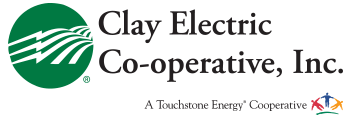Getting into summer now, with the temperature rising, has us thinking about electric bills. Clay Electric Co-operative gets a monthly electric bill just like all our members. Our bills from Southern Illinois Power Cooperative (SIPC) have four parts. Two types of demand charge (Noncoincidental Peak and Coincidental Peak), an energy charge and a power cost adder. How does what the cooperative pays compare to what you pay?
Let’s look at demand charges first. A demand charge is a fee for how many kilowatts (kWs) we need at any one time. This demand in kWs appears on your bill, though base residential rates are not charged a demand charge by CECI. The cooperative is charged two types of demand fees. Noncoincidental Peak (NCP) is the reading of the highest kWs needed by the system at any one point in time regardless of the overall grid’s peak demand. Coincidental Peak (CP) looks at the peak usage for all the members of SIPC and charges CECI for the highest demand within peak hours, even if the cooperative’s actual highest peak is outside those hours. NCP accounted for 31.5% of your cooperative’s last month’s power bill, while CP demand billing accounted for 20.8% of your cooperative’s bill. That’s more than half (52.3%) of our cost for power.
The next part of our bill comes from all the kilowatts we purchase that are used by our members, measured in kilowatt-hours (kWhs). This is the usage that you see on your residential bills. The cost for our kWh usage was 41.1% of the bill.
The last part of our bill, which accounts for 6.6% of the total, is a power cost adder (PCA). This is a representation of the fluctuation of the power market. It is a multiplier, that can be positive or negative, that will increase or decrease the electric bill depending on outside factors like fuel costs, market prices, transmission and distribution costs, etc. The benefit of a PCA is that it can account for changes in energy costs far more quickly than a change in rates could. Currently, CECI does not pass on the PCA charge to membership. CECI is always looking for ways to keep the cost of power down for our members.
CECI is a not-for-profit electric cooperative. It’s our goal to keep costs as low as possible while still paying the bills and keeping the lights on for our members. Each year we assign extra revenue to margins to be paid back at a later time through capital credits. Finding the best rate structure to cover costs and not overburden our membership is our primary goal in rate design.
Remember to keep an eye out for your member number in the middle of this magazine. We’ve hidden three member numbers in the pages. If you find yours and give us a call, you’ll get a $5 discount on your next bill! Happy hunting!
